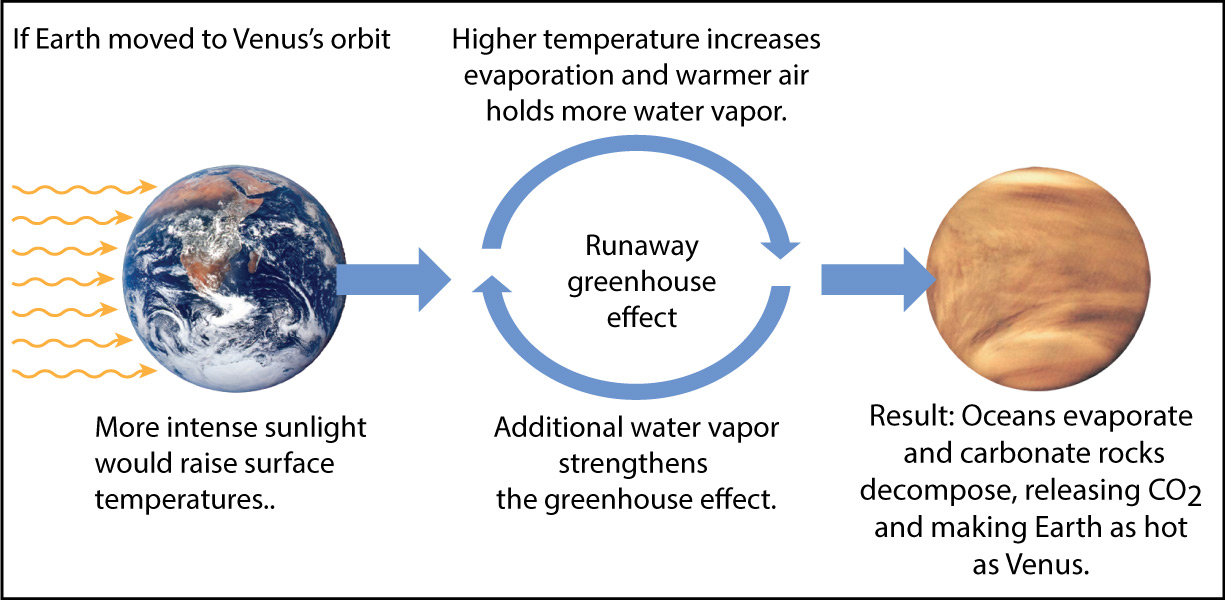Why does Venus have so much carbon dioxide in its atmosphere?
We’ve explained the mystery of Venus’s high temperature as being a result of having almost 200,000 times as much carbon dioxide in its atmosphere as Earth. But if you dig a little deeper, you may realize this opens up a new mystery: Why does Venus have so much more carbon dioxide than Earth?
We can answer this question on two levels. On the more basic level, the reason for the difference in atmospheric carbon dioxide is that Earth has oceans and Venus does not. Recall from Section 4.3.1 that on both planets, the original source of carbon dioxide was outgassing by volcanoes. On Earth, carbon dioxide dissolves in the oceans (which contain about 60 times as much carbon dioxide as the atmosphere), where it then combines with dissolved minerals to form carbonate rocks such as limestone (see this box ), which in total contain almost 200,000 times as much carbon dioxide as the atmosphere. Venus lacks oceans and therefore cannot dissolve carbon dioxide gas, so it all remains in the atmosphere. In other words, both planets have actually outgassed nearly the same amount of carbon dioxide, but Earth’s oceans have transformed almost all of that into rock while Venus’s carbon dioxide has remained airborne.
The deeper level on which we must answer the question concerns why Earth has oceans and Venus does not. Here, the answer actually does trace back to their differing distances from the Sun. You can understand the role of distance from the Sun by thinking about what would happen if Earth were magically moved to Venus’s orbit (Figure 1 below). The greater intensity of sunlight would immediately raise Earth’s average temperature by a few tens of degrees Celsius. This higher temperature would increase the evaporation of water from the oceans, putting much more water vapor into the atmosphere — and because water vapor is a greenhouse gas, the added water vapor would strengthen the greenhouse effect and drive temperatures even higher. The higher temperatures, in turn, would lead to even more ocean evaporation and more water vapor in the atmosphere, strengthening the greenhouse effect even further.
In other words, we’d have a reinforcing feedback process in which each little bit of additional water vapor in the atmosphere would lead to a higher temperature and even more water vapor. The process would rapidly spin out of control, resulting in what scientists call a runaway greenhouse effect. It would not stop until the oceans completely evaporated on the “moved Earth,” making it as hot as (or even hotter than) Venus is today. Note that this fact also explains how we know that Venus is not in the Sun’s habitable zone today (see Figure 4.54).
Interestingly, scientists suspect that something like this might actually have occurred on Venus long ago. Based on scientific understanding of how the Sun generates energy through nuclear fusion, the Sun should very gradually brighten with time. The rate is so slow that we cannot measure it, but the calculations indicate that the Sun was about 30% dimmer when the planets were born (about 4½ billion years ago) than it is today. This means that the sunlight hitting the young Venus would have been only slightly more intense than the sunlight at Earth today, in which case Venus would have been in the Sun’s habitable zone at that time. This, in turn, means that Venus might have had oceans when it was young. But as the Sun gradually brightened, Venus was doomed to a runaway greenhouse effect that would have completely evaporated any oceans it ever had, making it into the extremely hot planet that it is today.

